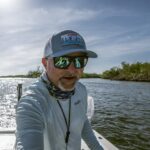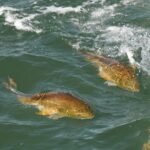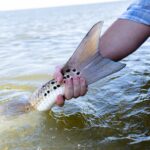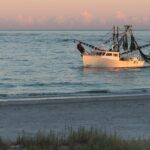
A Veteran Guide’s View of Jacks
If you’ve spent any time on the water in South Florida, chances are you’ve heard
By Tony Friedrich VP/Policy Director
Striped Bass Amendment 7 Brief Recap: One Down, Twenty-Six to Go
By Tony Friedrich VP/Policy Director
This blog is intended to give our readers a very brief recap of what happened at the Atlantic States Marine Fisheries Commission’s Striped Bass Board Meeting on Wednesday. A comprehensive blog will be published next week by our President, Capt. John McMurray. It takes a while to write a long article detailing all the twists and turns. We know you don’t want to wait. So, this is the best we can do right now.
The short version is that, in principle anyway, the vast majority of our preferred alternatives were approved by the Striped Bass Board. This is a good thing, and it bodes well for the future of striped bass, although we may have some difficult decisions to confront once the stock assessment update comes out this October. We’ll get into the nitty-gritty below, but for the visual learners among you here’s an infographic detailing what alternatives were approved and how they matched up with our priorities.
We are excited to announce a new award that we will give as needed after fisheries meetings. We are calling it the “Banana-On-Boat,” or BOB for short. What is the BOB, you ask? It is the fisheries equivalent of The Pinocchio award. You know when a public figure or an elected official lies about something, they get awarded one, two, three, or four Pinocchios depending on the severity of the fib. We hear some big fibs at these meetings. These fibbers should be held accountable, right? You shouldn’t be able to sit at the table as a commissioner tasked with sustainably managing our fisheries and spout lies constantly. Why don’t the other commissioners around the table put these folks in check? If they did, we wouldn’t be forced to hand out the BOB. But here we are!
Without further ado, we are happy (well, maybe that’s a stretch) to award our inaugural BOB to none other than Commissioner Tom Fote from New Jersey. Tom gets the maximum of Four BOBs for the whopper of a fib he told on the record at Wednesday’s meeting.
We livestreamed the meeting and video is a heck of a thing. We don’t have to wait weeks anymore for the audio to be published. We can pull quotes instantly. I think we will do this more often! Here is Tom’s quote:
“We keep talking about the environmental factors that affect this fishery, but let’s really talk about what has affected this fishery. In ‘95 there was very few striped bass fishermen coming off a moratorium and quite a few people not fishing for striped bass because you could fish for summer flounder, black sea bass, scup, and the only other regulations that were put on those species over the years that drove those fishermen to fish for striped bass. The hook and release mortality was probably 1/10th of what it is nowadays…Again, the hook and release mortality is probably 10 times, and I’m probably being conservative about the estimate of the increase.”
Well, Tom, we would like to direct you to the striped bass management page on the ASMFC website. You have been an ASMFC commissioner for over thirty years? We thought you might be familiar with the content but for everyone else, here a chart of the relative contributions to striped bass fishing mortality over the past four decades (we’ve added the red ovals)
 Catch and release mortality is just a number, 9%, applied to recreational releases. As you can see, the estimates in the mid-1990s are similar to those in the mid-2010s (the full estimates of release mortality by year can be found on page 141 of the draft amendment). Recreational release mortality has, and always will be, a major part of fishing mortality, which is not surprising given that the striped bass fishery is primarily recreational and primarily catch-and-release. It is fairly simple: Release mortality correlates to effort, and effort, which drives the economy, is a function of abundance.
Catch and release mortality is just a number, 9%, applied to recreational releases. As you can see, the estimates in the mid-1990s are similar to those in the mid-2010s (the full estimates of release mortality by year can be found on page 141 of the draft amendment). Recreational release mortality has, and always will be, a major part of fishing mortality, which is not surprising given that the striped bass fishery is primarily recreational and primarily catch-and-release. It is fairly simple: Release mortality correlates to effort, and effort, which drives the economy, is a function of abundance.
So, congrats Tom! You get the maximum of four BOBs for claiming on video that release mortality is 10 times higher now that it was in 1995. We know you hate catch-and-release fishing but we aren’t going to let you continue to say ridiculous things and not be held accountable. Again, we would rather not do this, but feel the need to when other commissioners sit in silence as these false claims are made. We aren’t the type of people that remain silent.
With that being said, let’s get into the meeting!
Section 4.1 Management Triggers
Tiers 1 and 2, Fishing Mortality (F) and Spawning Stock Biomass (SSB) were a clean sweep for our positions and keeping the triggers strong. We did not want any delay and the status quo triggers remained in place to continue requiring swift action, while also adding a new requirement to put a rebuilding plan in place within two years of determining the stock is overfished.
For Tier 3, Recruitment Triggers, Option A also ended up as a win, putting a more sensitive recruitment trigger in place. While the Board’s decision on Option B—required action when the recruitment trigger is tripped—reflects a significant improvement over status quo, it wasn’t our preferred option. The Board went with Sub-option B3, which reevaluates fishing mortality using interim reference points based upon the low recruitment scenario, not reference points from the stock assessment’s terminal year. While there was no public support for this option, it isn’t a terrible loss.
Tier 4, on deferred management action, wasn’t a terrible loss either. We pushed for status quo which said that the Board must respond to any trigger regardless of any active management actions. Instead, Option E passed, which states that the Board can defer action on a trigger that is tripped while another management action is active.
Section 4.2.2 Recreational Release Mortality
This section was a clean sweep for us. Gaffs are illegal for striped bass now. Stripers caught by non-approved methods must be safely returned to the water, and it is recommended that states conduct outreach on the best catch and release practices. While there was a robust discussion on potential effort controls in the form of seasonal closures, the Board went with our preference to not consider that approach as part of this amendment (Capt. McMurray will dig into this issue deeper in his full meeting rundown next week)
Section 4.4 Rebuilding
Rebuilding was also a clean sweep for the ASGA positions. We will rebuild under a low-recruitment scenario. Furthermore, if the stock assessment in October says we are in serious trouble, the Board can act swiftly to rebuild (still affording opportunities for public comment) rather than initiate a drawn-out addendum process.
Section 4.6.2 Conservation Equivalency
Numerous ASMFC commissioners told us that reforming Conservation Equivalency (CE) was the most important—and the most controversial—action needed to help striped bass as part of this amendment. We hoped to at least get one of our preferred options for this section. We ended up getting most everything we wanted. CE is all but dead for striped bass management, at least in the short term. It has been systematically abused by Maryland and New Jersey for too long. Maryland and New Jersey account for 68% of the total harvest of striped bass as per the 2020 numbers displayed in Table 17 on page 142 of the draft amendment.
With the Board’s approval of Option B, CE can no longer be used if the stock is overfished (below the SSB threshold). We are in a severely overfished state right now. Once we get above the threshold, CE proposals cannot use Marine Recreational Information Program (MRIP) estimates with a percent standard error (PSE) of greater than 40. We advocated for a PSE of 30 (consistent with NOAA Fisheries’ advice), but we still consider this a win. Maryland used MRIP numbers with a PSE of around 60 to close catch-and-release fishing in April. That isn’t allowed anymore, even after the stock recovers.
Remember the luxury tax on using CE that we’ve mentioned in past blogs? That was addressed in Option D. We wanted a front-end uncertainty buffer of 25% to be required for any state that uses CE. We got half of what we wanted. If the PSE on MRIP is below 30, states will need a 10% buffer. If the PSE is greater than 30, the buffer is increased to 25%. This makes CE very undesirable to the chronic abusers. We couldn’t be happier.
Finally, for defining CE, the state-specific rule, sub-option E2, passed. That means that when a coastwide reduction is initiated, the states that harvest the most must take the greatest reduction.
CE as we know it is dead. If there is one thing we wished for, this is it.
What’s Next
Over the past few days since the meeting, we have read a lot of comments on social media. Some were positive and some were negative. We have been doing this for a long time, and to be frank are kind of hardened by always being disappointed. Amendment 7 started as a delay tactic to not rebuild. It then transformed into a ticking time bomb to lower the reference points and continue unsustainable harvest. It ended up being a strong step forward for conservation. If you had told me two years ago that I would be writing a blog like this, I would have laughed at you.
We fought. We educated. We brought the entire community together and we won. Anyone who says public comment doesn’t matter should feel pretty silly today. It does matter. Things were bleak two years ago. Today, there is hope.
Take a few days and enjoy this victory but don’t get too comfortable. We cannot take our foot off the pedal. We have a stock assessment update coming up next fall and have to see this process through to the end.
If you were wondering what the sub-title of “One Down, Twenty-Six to Go” meant, here’s the truth. The problem with striped bass management is ASMFC. This process shouldn’t have been this hard. Two years of constant outreach. Eight years of science warning us. We should have taken the appropriate action in 2014 when we found out the stock would be overfished in a few years. But, with the flexibility of ASMFC, we ignored it. Did you know that ASMFC manages weakfish, river herring, menhaden, and cobia? All in all, ASMFC manages 27 species, and many are critical to our businesses up and down the coast. Striped bass management is just a symptom to the problem. Reforming the commission is the cure.

If you’ve spent any time on the water in South Florida, chances are you’ve heard

Photo Credit: Graham Tayloe Big Win for Redfish in Alabama Huge news from the Marine

Feature Photo: Carter Abramson | Simms Fishing at the Fisheries Science Symposium We have more

Each year, hundreds of millions of fish are killed as collateral damage from large-scale, inshore
We rely on our members and donations to keep fighting for a sustainable tomorrow in marine conservation.
GIVE THE GIFT OF FISHERIES CONSERVATION THIS HOLIDAY SEASON. SHOP ASGA GOODS THAT FUND FISHERIES RESEARCH & ADVOCACY CAMPAIGNS
JOIN ASGA IN CALLING FOR CRITICAL MANAGEMENT ACTION AFTER YEARS OF SPAWN FAILURES & POOR MANAGEMENT.
By using this website, you agree to our use of cookies. We use cookies to provide you with a great experience and to help our website run effectively. To learn more, please review our privacy policy.
4 Responses
Thank you for laying what was fought for and achieved at this point.
After the stock assessment in October , what changes or additional restrictions if any, can be enacted by the ASFMC.
( i.e. slot limit changes, trophy tags, partial seasonal closures, closure of spawning areas etc. )
Alan,
Everything is in the table. We can’t make any projections until we see the stock assessment. The assessment will give guidance on what needs to be done for rebuilding. We won one on Wednesday, but there is still a long road ahead.
Thank you for your hard work. It seems like menhaden should be the next priority, given its place in the food chain and given the fact that it is mostly foreign interests harvesting them.
A well done to all those that took the time to comment.